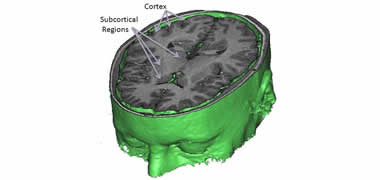
Cortex and subcortical regions: The study looked at the size of sub-cortical brain regions that are involved in some basic functions such as memory, movement, learning and motivation. New insights may help scientists better understand disorders such as schizophrenia, Alzheimer’s disease and epilepsy
An international study, which included researchers from NUI Galway, has identified significant genetic factors that influence the size of structures within the brain. It is hoped these new insights may help scientists better understand disorders such as schizophrenia, Alzheimer’s disease and epilepsy. The research was published today in Nature magazine.
NUI Galway professor of psychology, Professor Gary Donohoe, led the Irish contribution to the study, which involved a consortium of almost 300 scientists from 193 institutes – including NUI Galway. The consortium, known as the ENIGMA (Enhancing Neuro Imaging Genetics through Meta-Analysis), shared results from analyses of genetic data and MRI scans from more than 30,000 individuals worldwide.
The study looked at the size of sub-cortical brain regions that are involved in some basic functions such as memory, movement, learning and motivation. Abnormalities in these brain regions are associated with neurological and mental health disorders.
According to Professor Donohoe: “For years, scientists have been fascinated by the development of different brain structures and how this changes in brain-based disorders. In this study, we have used MRI scans to look at how the size of different brain regions is influenced by our genes and obtained some fascinating results. We have found, for example, one gene variant that affects the size of the Putamen, a region near the centre of the brain which resembles the stone in the middle of a fruit.The Putamen is partly responsible for movement and learning, and is implicated in Parkinson’s disease. This finding opens up new avenues for research in this disease by giving new clues about the biological mechanisms involved.”
The research was in part funded by Science Foundation Ireland and the Health Research Board in Ireland and involved collaboration between researchers at NUI Galway and Trinity College Dublin.
“Knowledge about the genetic basis of these structures provides important insights into how the brain develops”, said Professor Donohoe. “These insights are important both to understanding normal human development and to understanding the basis of neurodevelopmental and neurodegenerative disorders such as schizophrenia, Alzheimer’s disease and epilepsy. Given the likelihood that thousands of variants are involved, large scale international efforts such as in this study are an important step in unravelling this genetic and biological complexity so as to develop new and better treatments.”
“ENIGMA’s scientists screen brain scans and genomes worldwide for factors that help or harm the brain”, said ENGIMA co-founder Professor Paul Thompson from University of Southern California. “This crowd-sourcing and sheer wealth of data gives us the power to crack the brain’s genetic code.”
Dr Sarah Medland of QIMR Berghofer in Australia, was senior-author on the study, and added: “Unless you know what ‘normal’ development looks like it’s hard to know how disease manifests in these sub-cortical regions. Previously it has been too expensive for any one institute to collect enough scans and genetic data to make this kind of study possible. By working together in large collaborative projects we can tackle these types of problems and further our understanding of the biology of the brain.”
Five genetic variants identified
The study identified five genetic variants that influence the size of structures within the brain. Of the genetic associations found, the largest effect was seen for the Putamen, a subcortical region located at the base of the forebrain, which is important for movement and reinforcement learning. This variant is located within the KTN1 gene that encodes the protein Kinectin, a receptor important for cell function. In follow up protein expression work this variant was found to alter the expression of KTN1 in frontal cortex. The study also found evidence of several variants being associated with hippocampal volume (a brain region synonymous with memory encoding and retrieval), one of which has previously been implicated in risk for schizophrenia.
The article published in Nature today is ‘Common genetic variants influence human subcortical brain structures’.
This research at NUI Galway was undertaken by the Cognitive Genetics and Therapy Group (Principal Investigators: Prof Gary Donohoe and Dr Derek Morris) and the Clinical Neuroimaging Laboratory (Principal Investigators: Prof Colm McDonald and Dr Dara Cannon).
More information about the ENIGMA project is available at http://enigma.ini.usc.edu/